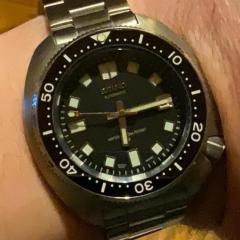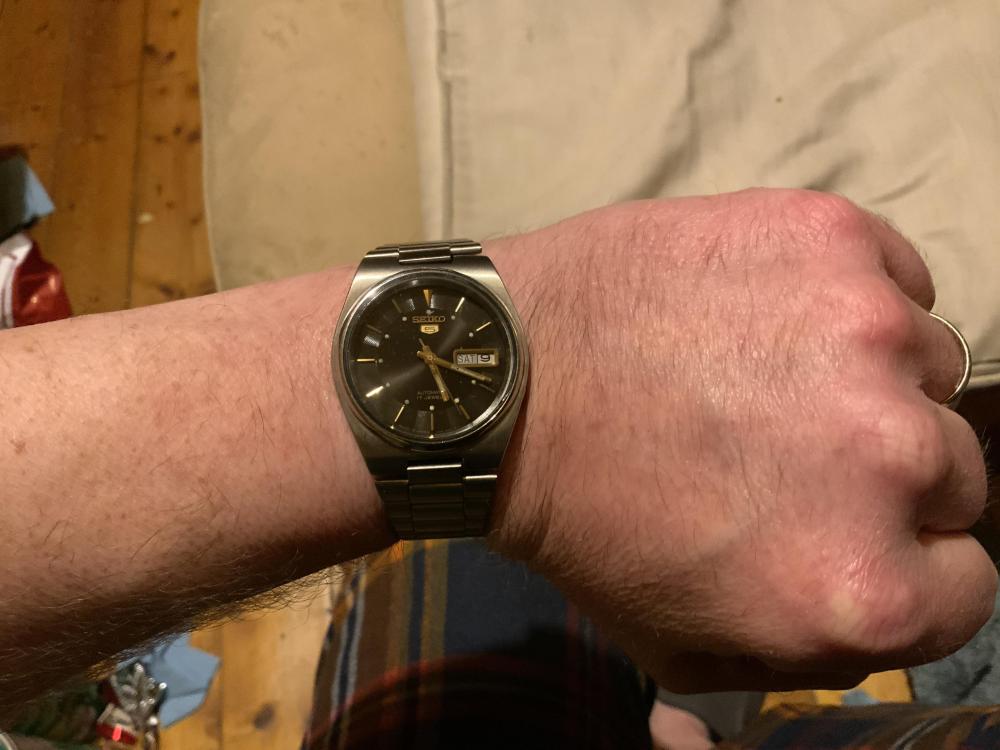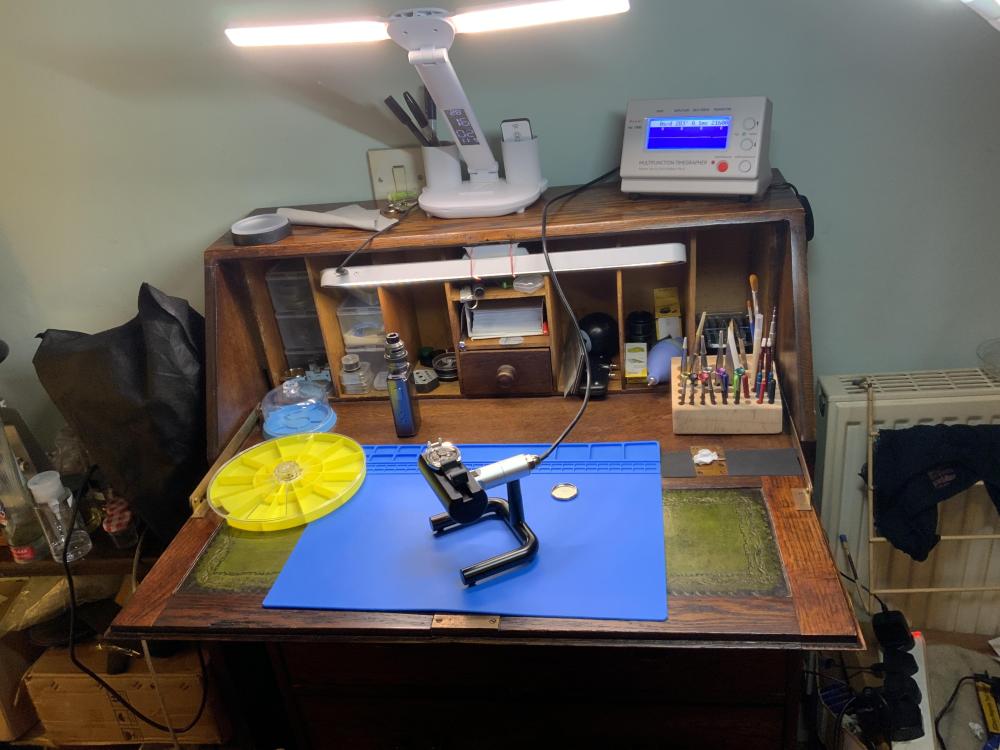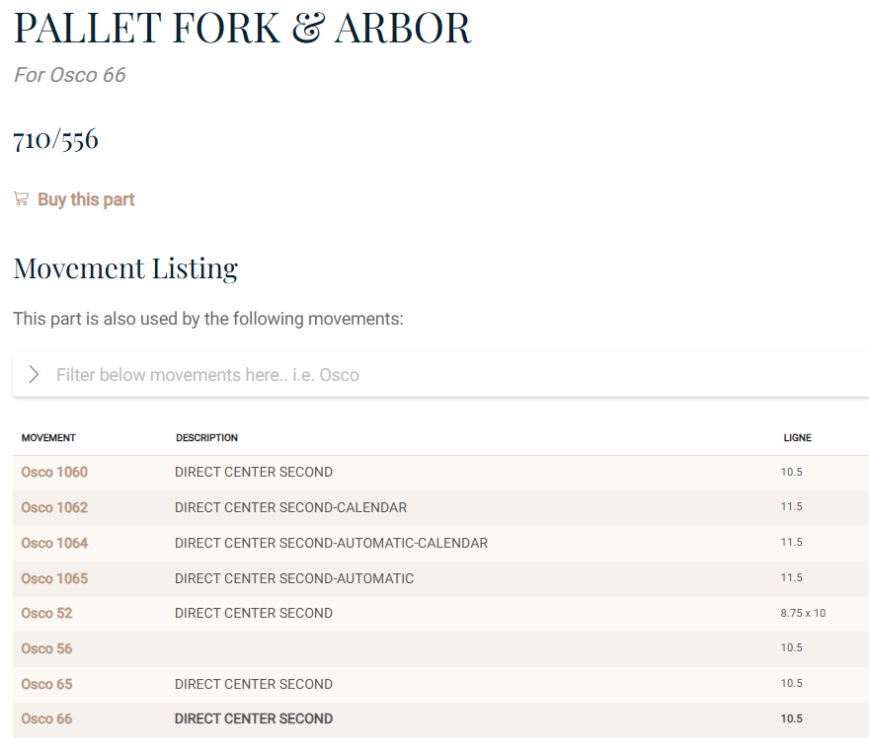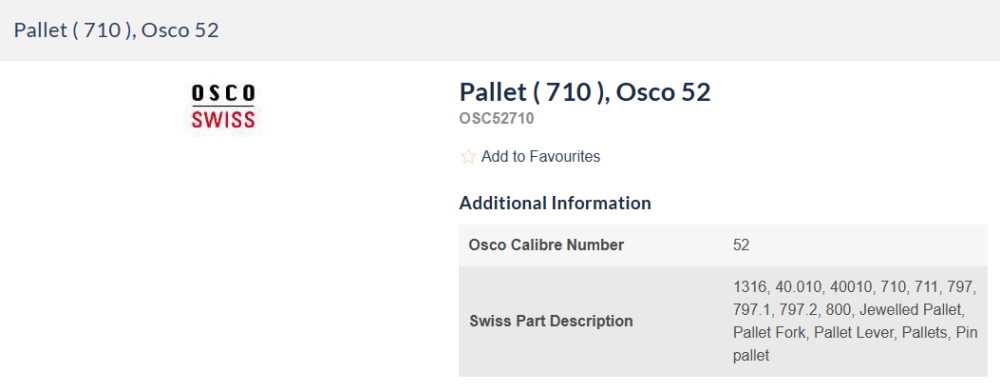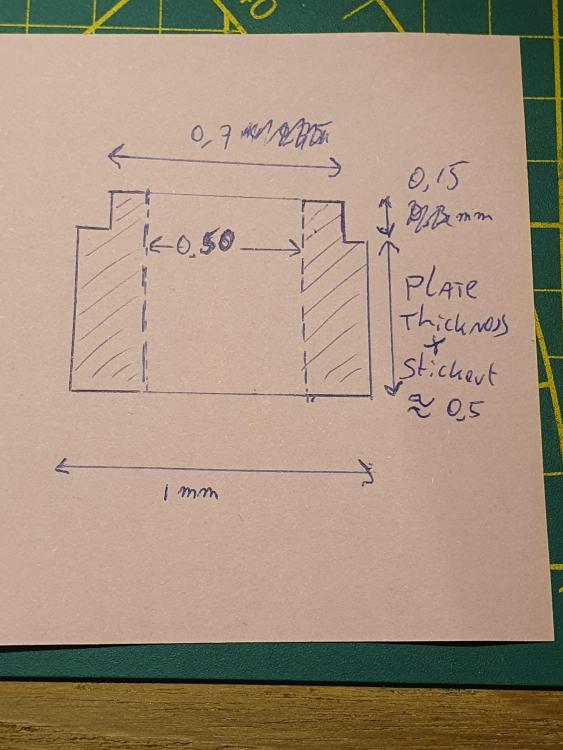Leaderboard
Popular Content
Showing content with the highest reputation on 12/01/24 in Posts
-
There is a Swiss generic part number system as defined by Ebauches SA. For instance 210 is a third wheel, 710 a pallet fork, 401 winding stem, 410 winding pinion, etc.2 points
-
It was an original 'Nivaflex' spring from Gleave and Co. which I don't think they sell that anymore and instead the GR spring. I fit a lot of mainsprings. One thing I came to realise from experience and seeing the results of those mainsprings is, you can get information about the size of the mainspring from several good sources and they may all give the dimensions as slightly different. One source I generally look at first is the GR catalogue, but I can find that a spring is either too strong or clearly too weak for that movement, even though the catalogue says it is correct. I may have to go up or down one strength. Now, I would start to think it was the wear of the movement, etc. for me to up the strength of the spring, but most of the time it is having to come down in strength to stop the knocking (re-banking). I've found this to be the case with some vintage JLC's, Tudor and a Rolex 1200, so maybe it's the makers of the mainsprings that make them slightly stronger or weaker, even though the pack says the correct size.2 points
-
Well I have been fascinated with watches since a child, a very long time ago, and always fiddled with them. Since YouTube started I have watched watch repair videos and have finally taken the plunge to get into watch service and repair. As is normal for me I have done my research and collected most of the tools I needed before I even touched my first watch, a Seiko 7009a which I finished last weekend. Didn’t have too many problems apart from loosing a screw (now found in my Rodrco) lost the mainspring arbor, it pinged and I still haven’t found it and positional variance on the timegrapher but in real world use accuracy is a ew seconds a day. It’s great to see such an active forum with such a positive bunch of people.2 points
-
2 points
-
Given more time you could look at resin casting a new base.2 points
-
This can apply to a lot of the cleaning solutions that are used in watchmaking, and I think the key terms here are "high levels" and "long term exposure". If it's use is restricted to cleaning hairsprings only then neither of these terms apply. The amounts used are very small and last for short periods of time, also the usual practice is to clean the hairspring in a capped bottle. But as with all advice caution should be applied because, everyone is different and everyone reacts differently. If you feel unwell from any exposure to a substance you should remove yourself from the environment, or improve the environment in which you are working .2 points
-
1 point
-
The Swiss standardised the base part numbers for movements. You will have lots of movements with the part number 710 and none of them are compatible. Tom1 point
-
1 point
-
1 point
-
1 point
-
1 point
-
It should sit in the grove of the glass. I have come across quite a few in my time. What glass fitting tool are you using?1 point
-
Hey all, I am an enthusiast and enjoy tinkering with the straps on my watches - a vintage Omega Speedmaster 145.022 I found years ago at an estate sale, a blue Omega SMP 300M the (version introduced in 2018), and a few Victorinox watches I picked up in high school and college. I leave the servicing of my movements to the pros, but am interested in learning how to change the batteries on my quartz collection and thought this forum looked like a welcoming place to learn. It is really incredible how many members there are. Thanks for having me!1 point
-
Yes I have. It's quite common. I would put the open ends in first and then press around on both sides until it seats completely.1 point
-
For us amateurs, we should err on the side of caution when experimenting with new equipment or solutions. Since we're not on the clock, the cleaning process can be repeated if not satisfactory.1 point
-
1 point
-
I have some body filler in the garage. I will look at that for reinforcing on the underside of the base. Great idea!1 point
-
You need to remove the 2 big screws before the plastic ring will come out. There shouldn't be any need to remove the stem but make sure you hold the movement down while removing this ring.1 point
-
Yay a picture kiddo, a nice looking ETA movement , so the plastic movement ring is just a retainer to keep the movement stable in the case. Usually these come out with a little jiggling and holding the movement in position but it also looks like you may have two case screws to remove as well. Start by deciding if the plastic movement ring has some of itself under the movement and are the case screws attached to it. Usually the ring would just lift out to make for an easy battery change, this may not be the case with yours so tread carefully with this step. Report back when you've verified how that ring is installed. You see the little steel pin with the arrow pointing to it from the gold circuit trace, this might be the stem release button, it looks to be located in the correct place with the stem notch. Dont press and try to remove the stem just yet, that step might not be required but its worth discovering if that is the release button. All of this movement is delicate especially the coil, use plastic tweezers if you have them, if not tape up the tips of your metal ones to protect the movement from damage or short circuit. If this is your first time in a watch you need to be wary of what you can and can't touch.1 point
-
We have literally thousands of members here past and present, regular weekly visitors maybe only fifty or so, but within those fifty is wealth of knowledge you wont find anywhere else on the planet. Okay so the first thing we need to discuss is your lack of picture posting , you have some watches and that means we need to see them, enjoy the forum kiddo .1 point
-
school experiences and watch repair can be quite interesting. the first school had a variety of cleaning machines with one of the moved the basket from cycle to cycle and it had a timer of 10 minutes. So they can go 10 minutes I went 10 minutes it also ran with vacuum tubes big vacuum tubes which unfortunately elevates the temperature the cleaning fluid. Typically with cleaning fluids they do not recommend elevating the temperature as it speeds things up. So what did I learn that day well the solution turned a really pretty blue-green color? That's because the ammonia and I don't know enough about the non-ammonia as it still has brightening properties so I'm going to assume it has the same. In other words the properties will take off the tarnish and make things bright and shiny but once you go beyond that it will start dissolving things like copper in to the solution turns a pretty blue-color and this particular watch that had nice shiny brass plates now had frosty plates. So I tend to really worry about elevated temperatures and long time spans. In the second school where we had one machine the time control for cleaning had been taped to four minutes. So all day long we are cleaning watches on a continuous basis but not cleaning over four minutes. then that was the cleaning cycle I'm assuming because I can't remember that that would include the rinses to. the chemicals in the cleaning bath that make things bright and shiny do a nice job as long as you do not speed things up by elevating the temperature and extending the time. As long as your solution is not turning a pretty blue-green color as your dissolving out the copper and his long as everything looks bright and shiny and clean and I guess you're doing okay. Then personally as far as the rinses go I don't worry about them because they don't have any brightening chemicals. Thought they had to run away and do something I would leave it a longer time span but I To really close eye on the cleaning itself.1 point
-
That is not the correct ring. Someone has cut that ring down to size.1 point
-
You are welcome young man ( Just reminded myself of Harry Enfield's Dirty old Ladies " Young man " sketches LOL. So some reversing of the escapewheel is a good indication that the train is acceptably friction free, it doesn't necessarily mean that there are really bad things going on if you don't see it. But if its coming to an abrupt halt then you obviously need to be searching for some friction lurking somewhere, but it can depend on how well the train gear is meshing what you might see. Its just really nice to see it reverse, no hard and fast rules apply. Think we need some Harry Enfield now.....and for the faint hearted, look away and put on some ear muffs https://youtu.be/C2hgAsi8Ae4?si=4bg9oKxZn8HhqQ3B1 point
-
My grandaughter that just got married has a musical rotating porcelain bear in a clown suit that had seen better days. It plays a short part of 'Send in the Clowns'. To wind it, it should have been lifted up and the plastic base that attached to the winding arbor of the music box turned to wind it up and then ireplace it on its base to rotate while it played. What had been done is people had pushed down on the bear while it was sitting on a bedside table etc to wind it. The result of that is the base centre that attached to the winding arbor had completely broken out of the base and the cover of the mainspring barrel on the music box had completely broken from the pressure of winding. All the bits were there so I took it apart as much as I could as it is riveted together so cleaning was going to be difficult. I put all the parts of the music box into the ultrasonic cleaner which has done a great job of cleaning it. I was able ro remove the mainspring which was quite set. I spent some time running the spring over a piece of round in my vice. I was able to increase the diameter of the spring and finally got some of the coils to come away from others. Allow had to fiddle around with the centre coil as it was not grabbing the arbor very well. Lubricated the mainspring and wound it back in by hand. Then worked out a way to clamp the broken part of the cover to the main part and used some 5 minute Araldite to glue the cover as well as the plastic base. Got that done before I went into hospital so the part stayed clamped for about 3 days before I took the clamp off. I should have taken more photos, but I want to get it done and sent back to Sydney before Bec & Jarryd's baby grows up. I have to make a new wooden cover that the music box is screwed to which is in turn glued to the porcelain. Hopefully get the base cut and drilled tomorrow and get it all back together. The click for the mainspring is a molded plastic setup on the arbor underneath the mainspring in its barrel. Nothing I could do with it after the damage sustained from the incorrect winding. It still works, but I will be telling Bec that if it fails again, it'll be unrepairable. I'll take some phots of it all tomorrow. Ok. It's not a clock, but principles are the same. Hey, I'm working my way up to a clock. It'll be my grandmothers Hettich first as that has been in bits for years now. A bit embarrassing really.1 point
-
With ultrasonic cleaning, you want the minimum time which gets everything clean. I cut down the times I use to 4 mins clean, 2 mins for each rinse. I've found it's enough to get things really clean. Documentation for Elma WF Pro cleaner says use for "2-10mins", and Suprol Rinse "about 3 mins".1 point
-
There used to be a couple of guys here that swore by Hexane for hairspring cleaning Jon ,they said it evaporated very quickly though and to make sure it was bottled up tight.1 point
-
one of the problems with the bestfit book is it's based on parts parts listing etc. were available. There is no point in listing watches that no parts are available. there is a problem of time range of the bestfit it only really covers watches ever relevant in the mid-60s to somewhere in the 70s and if you're outside of that range is not going to comfort even though it appears to be they found your mainspring for you it would be helpful if we knew the dimensions of the spring you're looking for? then maybe they didn't find the mainspring what is the problem with the end or basically what does the end look like?1 point
-
not only do you need to get pictures but you really should explain to people what this is? Like for instance I don't see the crown anywhere what happened to the crown? plus usually given photos the front has more than likely most people in this group haven't ever seen one of these. Then you're going to have problems because this is definitely a vintage watch. I have two links below the first link somebody asks the same question you have and you'll see lots of confusion. but if you scroll down you'll finally get to the answer there is a article in the horological times magazine. otherwise it just isn't a lot of information on this is for servicing it goes. then for those that don't know what this is the second link gives you the history of talks about it until blame of the title first automatic wristwatch. https://mb.nawcc.org/threads/harwood-automatic.21429/ https://www.fratellowatches.com/tbt-john-harwood-and-the-worlds-first-automatic-wristwatch/1 point
-
Thanks for the Information! Probably that will be the next best option -> to purchase a donor movement and use the 1134 Framework. Yes, I was until now also not successfull in finding any documentation containing information on the jewel itself... Neither does the movement datasheet contain such information... I have uploaded it -> maybe interesting for other readers... ETA 2472.pdf1 point
-
Shock is one of the best things to release a rusted together part. If you have a staking tool, rest the barrel arbor in a stump, and come down with a flat face punch on the screw, good contact, then one sharp smack with the hammer. If you don't have a staking tool, you can try with some other means of support and punch but would be less ideal. Then work the screw, putting pressure in both directions, until it starts to move. As said, there's a chance it's left hand thread, but sometimes going the "wrong" way a little helps loosen things up.1 point
-
Looking forward to see what wonders (or gremlins) are beneath the case back.1 point
-
Thanks....I am not really starting out, I have done maybe 20 previous watches including a Bell-Matic and feel like I am ready to had least have a pop at this one! It hasn't arrived yet, but I will check the number when I have it.1 point
-
Perhaps the most stupid question ever asked on WRT, but why does one need such an arbor holder ? Is this one of those tools I never knew I couldn't live without?1 point
-
Yes that's definitely an interesting place to visit. Here's a video of a clock which is interesting because you can get the plans for. There may be useful information in the book https://youtu.be/6h6Ic5RCIq0 Yes I think you might find the book helpful he does show how to make one he shows all the steps he also shows all the parts it might be helpful. Since you can go to the BHI they should have one in the library Don't know if they allow people a borrow books of the library or not? But if I remember right they did have a room where you could read the books there. I think what you're describing is exactly what is supposed to happen. Unwound the Cable should be entirely on the mainspring barrel with A very tiny amount of poll to keep the whole thing from falling off for its unwound just enough to keep it in place. Then you wind the fusee which has the internal clicks which you may not Be able to see at one end. So you should Be able to wind it all over to the fusee but I wouldn't do that with the amount of power you have if it's not running should Just wind a little bit. Then the whole thing will just sit there and do absolutely nothing at all unless the clock itself is running. So it's actually sounds like it's all working except the course your picture sews the cable around the fusee barrel where it's not supposed to be.1 point




